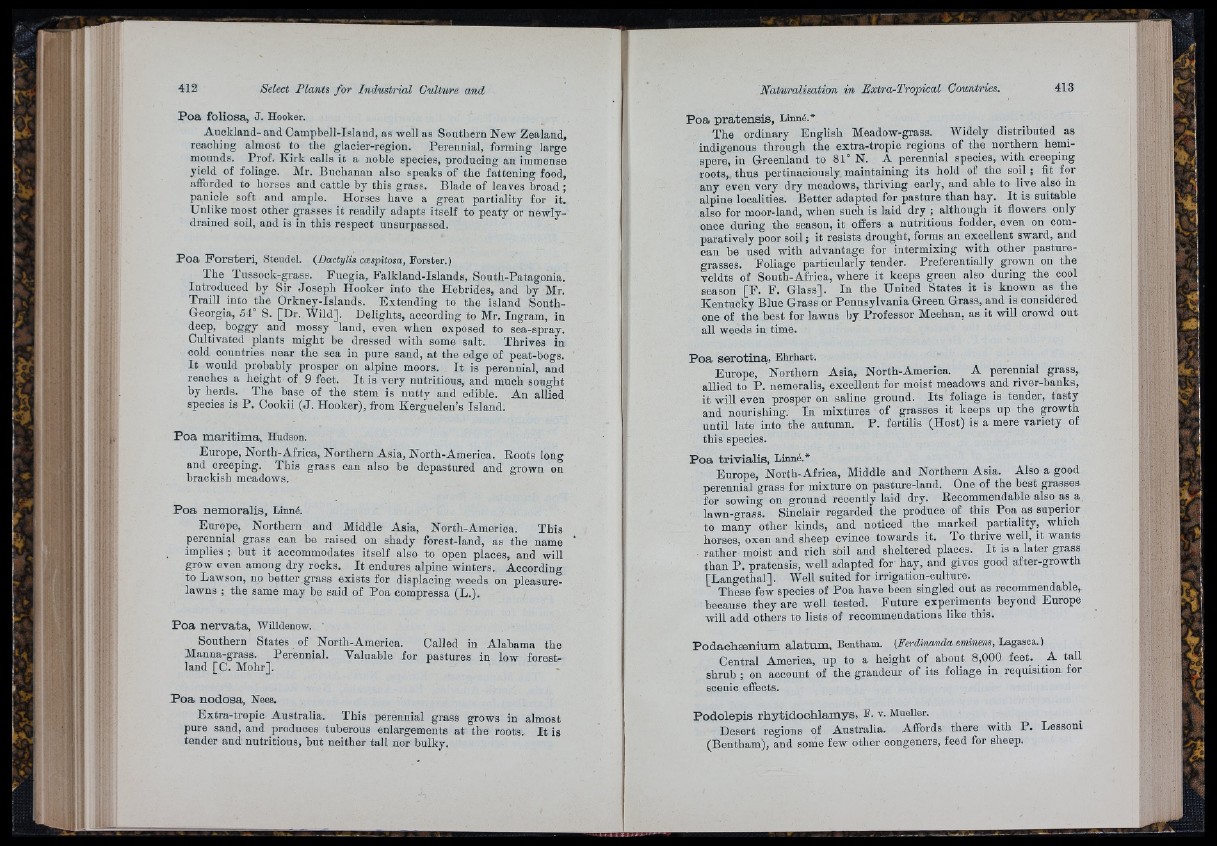
Poa foliosa, J. Hooker.
Auckland- aud Campbell-Island, as well as Southern New Zealand,
reaching almost to the glaeier-region. Perennial, forming large
mounds. Prof. Kirk calls it a noble species, producing an immense
yield of foliage. Mr. Buchanan also speaks of the fattening food,
afforded to horses and cattle by this grass. Blade of leaves broad ;
panicle soft and ample. Horses have a great partiality for it.
Unlike most other grasses it readily adapts itself to peaty or newly-
drained soil, and is in this respect unsurpassed.
Poa Forsteri, Steudel. {Dactylis cæspitosa, Forster.)
The Tussock-grass. Fuegia, Falkland-Islands, South-Patagonia.
Introduced by Sir Joseph Hooker into the Hebrides, and by Mr.
Traill into the Orkney-Islands. Extending to the island South-
Georgia, 54° S. [Dr. Wild]. Delights, according to Mr. Ingram, in
deep, boggy aud mossy land, even when exposed to sea-spray.
Cultivated plants might he dressed with some salt. Thrives in
cold countries near the sea in pure sand, at the edge of peat-bogs.
I t would probably prosper on alpine moors. I t is perennial, and
reaches a height of 9 feet. I t is very nutritious, and much sought
by herds. The base of the stem is nutty and edible. An allied
species is P. Cookii (J . Hooker), from Kerguelen’s Island.
Poa maritima, Hudson.
Europe, North-Africa, Northern Asia, North-America. Roots long
and creeping. This grass can also be depastured and grown on
brackish meadows.
Poa nemoralis, Linué.
Europe, Northern and Middle Asia, North-Ameriea. This
perennial grass can be raised on shady forest-land, as the name
, implies ; but it accommodates itself also to open places, and will
grow even among dry rooks. I t endures alpine winters. According
to Lawson, no better grass exists for displacing weeds on pleasurelawns
; the same may be said of Poa compressa (L.).
Poa nervata, Willdenow. '
Southern States of North-Amerioa. Called iu Alabama the
Manna-grass. Perennial. Valuable for pastures in low forestland
[C. Mohr],
P o a nodosa, Nees.
Extra-tropio Australia. This perennial grass grows iu almost
pure sand, and produces tuberous enlargements at the roots. I t is
tender and nutritious, but neither tall nor bulky.
Poa pratensis, Linné.*
The ordinary English Meadow-grass. Widely distributed as
indigenous through the extra-tropic regions of the northern hemi-
spere, in Greenland to 81° N. A perennial species, with creeping
roots, thus pertinaciously maintaining its hold of the soil ; fit for
any even very dry meadows, thriving early, and able to live also in
alpine localities. Better adapted for pasture than hay. I t is suitable
also for moor-land, when such is laid dry ; although it flowers only
once during the season, it offers a nutritious fodder, even on comparatively
poor soil ; it resists drought, forms an excellent sward, and
can be used with advantage for intermixing with other pasture-
grasses. Foliage particularly tender. Preferentially grown on the
veldts of South-Africa, where it keeps green also during the cool
season [F . F . Glass]. In the United States it is known as the
Kentucky Blue Grass or Pennsylvania Green Grass, and is considered
one of the best for lawns by Professor Meehan, as it will crowd out
all weeds in time.
Poa serótina, Ehrhart.
Europe, Northern Asia, North-America. A perennial grass,
allied to P. nemoralis, excellent for moist meadows and river-banks,
it will even prosper on saline ground. I ts foliage is tender, tasty
and nourishing. In mixtures of grasses it keeps up the growth
until late into the autumn. P. fertilis (Host) is a mere variety of
this species.
Poa trivialis, Linné.*
Europe, North-Africa, Middle and Northern Asia. Also a good
perennial grass for mixture on pasture-land. One of the best grasses
for sowing on ground recently laid dry. Reeommendable also as a
lawn-grass. Sinclair regarded the produce of this Poa as superior
to many other kinds, and noticed the marked partiality, which
horses, oxen and sheep evince towards it. To thrive well, it wants
rather moist and rich soil and sheltered places. I t is a later grass
than P . pratensis, well adapted for hay, and gives good after-growth
[Langethal]. Well suited for irrigation-culture.
These few species of Poa have been singled out as reeommendable,
because they are well tested. Future experiments beyond Europe
will add others to lists of recommendations like this.
Podaohsenium alatum, Bentham. (Ferdinanda eminens,
Central America, up to a height of about 8,000 feet. _ A tall
shrub ; on account of the grandeur of its foliage in requisition for
scenic effects.
Podolepis rhytidoohlamys, E. v. Mueller.
Desert regions of Australia. Affords there with P . Lessoni
(Bentham), and some few other congeners, feed for sheep.